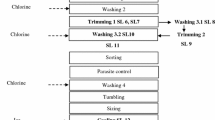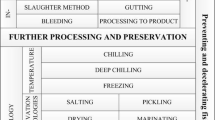Abstract
Although the farming of Pangasianodon hypophthalmus is of worldwide economic importance, only little scientific information is currently present on the microbiological quality and safety of these fish fillets throughout the processing chain. This research assessed the microbiological quality and safety of P. hypophthalmus in a Vietnamese Pangasianodon processing company as a case study. The company was initially characterized by a diagnosis of the food safety management system (FSMS) performance by an in-depth interview, which is referred to as a diagnostic instrument. Secondly, a microbiological assessment scheme (MAS), an active and repetitive sampling methodology, was used to evaluate the food safety output and the microbiological quality from raw material until final product. The overall MAS result (level 2) was found to be slightly lower than the company’s food safety performance indicators had indicated (level 2–3). It can be concluded that the microbiological risk of the Vietnamese company and its products is medium high. This is mainly due to the lack of data and knowledge regarding the origin and composition of the microbiological flora present in the fish and in the processing environment. The variability in concentrations of microorganisms also contributed to this lower MAS score and could probably be reduced by improving some specific aspects of the FSMS and the production process.





Similar content being viewed by others
References
Anonymous A (2004) Regulation (EC) No 852/2004 of the European parliament and of the council of 29 April 2004 on the hygiene of foodstuffs. Off J Eur Union 139:1–54
EFSA (2010) Development and implementation of a system for the early identification of emerging risks in food and feed. EFSA J 8:1888
FAO (Food and Agriculture Organization of the United Nations) (2010) The state of world fisheries and aquaculture. Office of Knowledge Exchange, Research and Extension, FAO, Rome
Gram L, Huss HH (1996) Microbiological spoilage of fish and fish products. Int J Food Microbiol 33:121–137
Huebner J, Goldmann DA (1999) Coagulase-negative staphylococci: role as pathogens. Annu Rev Med 50:223–236
ICMSF Microbial ecology of food commodities (2004) Microogranisms in foods 6. Kluwer Academic/Plenum Publishers, New York
ICMSF Microbiological specifications of food pathogens (1996) Microorganisms in foods 5. Chapman & Hall, Londen
Jacxsens L, Kussaga J, Luning PA, Van der Spiegel M, Devlieghere F, Uyttendaele M (2009) A microbial assessment scheme to measure microbial performance of food safety management systems. Int J Food Microbiol 134:113–125
Lake R, Hudson A, Cressy P (2003) Risk profile: Vibrio paraheamolitucus in seafood. New Zealand Food Safety Authority Report: 2003
Luning PA, Bango L, Kussaga J, Rovira J, Marcelis WJ (2008) Comprehensive analysis and differentiated assessment of food safety control systems: a diagnostic instrument. Trends Food Sci Technol 19:522–534
Luning PA, Marcelis WJ, Rovira J, Van der Spiegel M, Uyttendaele M, Jacxsens L (2009) Systematic assessment of core assurance activities in a company specific food safety management system. Trends Food Sci Technol 20:300–312
Luning PA, Jacxsens L, Rovira J, Oses SM, Uyttendaele M, Marcelis WJ (2011) A concurrent diagnosis of microbiological food safety output and food safety management system performance: cases from meat processing industries. Food Control 22:555–565
Nair GB, Bhadra RK, Ramamurthy T, Ramesh A, Pal SC (1991) Vibrio cholerae and other Vibrios Associated with paddy field cultured prawns. Food Microbiol 8:203–208
Orban E, Nevigato T, Di Lena G, Masci M, Casini I, Garnbelli L, Caproni R (2008) New trends in the seafood market. Sutchi catfish (Pangasius hypophthalmus) fillets from Vietnam: nutritional quality and safety aspects. Food Chem 110:383–389
Phan LT, Bui TM, Nguyen TTT, Gooley GJ, Ingram BA, Nguyen HV, Nguyen PT, De Silva SS (2009) Current status of farming practices of striped catfish, Pangasianodon hypophthalmus in the Mekong Delta, Vietnam. Aquaculture 296:227–236
Prasad RH, Kharidehal N (2006) Vibrio Metschnikovii sepsis in a neonate. Int J Pediatr Neonatol 6. doi:10.5580/b21
Rahman MM, Islam MS, Halder GC, Tanaka M (2006) Cage culture of sutchi catfish, Pangasius sutchi (Fowler 1937): effects of stocking density on growth, survival, yield and farm profitability. Aquac Res 37:33–39
Reinartz M, Alter T, Hildebrandt G, Jacob J, Kleer J (2011) Impact of the deep freezing process and frozen storage on the microflora of two frozen convenience food products. Fleischwirtschaft 91:111–114
Ringo E, Gatesoupe FJ (1998) Lactic acid bacteria in fish: a review. Aquaculture 160:177–203
Sampers I, Jacxsens L, Luning PA, Marcelis WJ, Dumoulin A, Uyttendaele M (2010) Performance of food safety management systems in poultry meat preparation processing plants in relation to Campylobacter spp. contamination. J Food Prot 73:1447–1457
Sampers I, Toyofuku H, Luning PA, Uyttendaele M, Jacxsens M (2011) Semi-quantitative study to evaluate the performance of a HACCP-based food safety management system in Japanese milk processing plants. Food Control 23:227–233
Sarter S, Nguyen HNK, Hung LT, Lazard J, Montet D (2007) Antibiotic resistance in gram-negative bacteria isolated from farmed catfish. Food Control 18:1391–1396
Seaman P (2010) Food hygiene training: introducing the food hygiene training model. Food Control 21:381–387
Sorensen NK (2005) Slaughtering processes for farmed Pangasius in Vietnam. Consultancy surveying slaughter processes and by-products handling in the Vietnamese industry. Fiskeriforskning report 12 ed
Uyttendaele M, Jacxsens L, De Loy-Hendrickx A, Devlieghere F, Debevere J (2010) Microbiological guide values and legal criteria. Ghent University, Ghent
Vijayabaskar P, Somasundaram ST (2008) Isolation of bacteriocin producing lactic acid bacteria from fish gut and probiotic activity against common fresh water fish pathogen Aeromonas hydrophila. Biotechnology 7:124–128
Acknowledgments
We thank the companies involved in this research for allowing to use company results and for their willingness and hospitality to cooperate with the researchers here involved.
Author information
Authors and Affiliations
Corresponding author
Rights and permissions
About this article
Cite this article
Noseda, B., Tong Thi, A.N., Rosseel, L. et al. Dynamics of microbiological quality and safety of Vietnamese Pangasianodon hypophthalmus during processing. Aquacult Int 21, 709–727 (2013). https://doi.org/10.1007/s10499-012-9605-6
Received:
Accepted:
Published:
Issue Date:
DOI: https://doi.org/10.1007/s10499-012-9605-6




